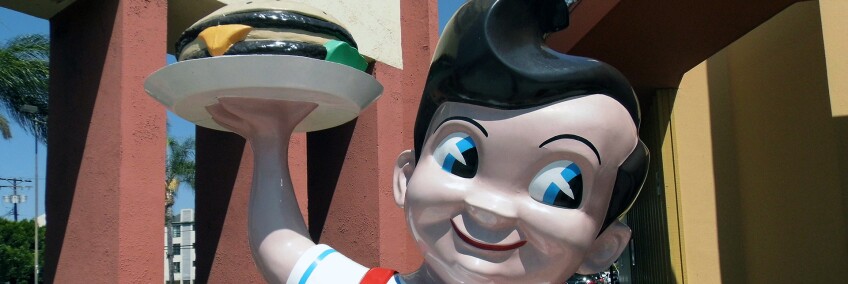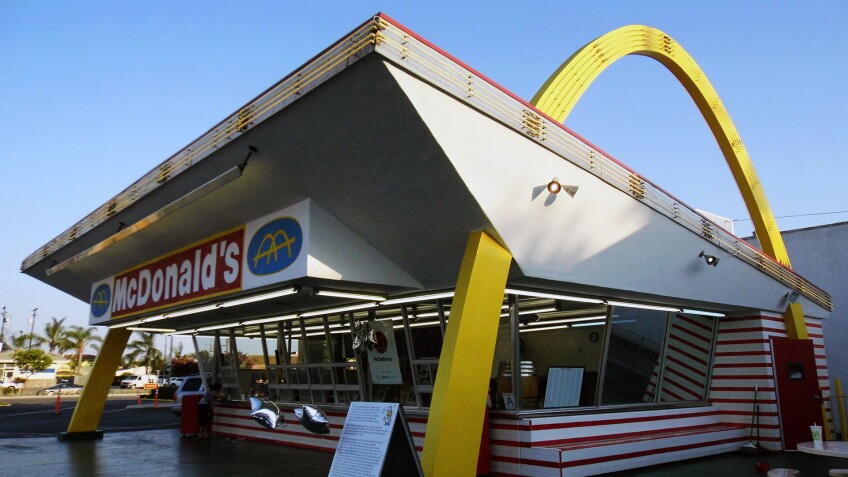Where to Find the Birthplaces of Five Iconic SoCal Chain Restaurants

When wandering through southern California, you’re bound to work up an appetite. And fortunately, our local eats provide choices galore — whether you crave street tacos and tamales, ramen, chilidogs, or avocado toast.
An essential part of the SoCal experience is to argue about who first offered a French dip or who flips the best burger and to take pride in our world-famous pancakes and pastramis.
But as much as we forage at our local farmers markets and pick the fruit off our neighbors’ trees, there’s something else that true southern Californian locavores need to do. It’s time to embrace the food chains that were born and raised in the southernmost reaches of the Golden State!
With as much produce, nuts and other foodstuffs that California ships out to the rest of the country, some of our biggest exports have been some of the best-known and most beloved eateries that have evolved into American institutions.
So, pack your bags for a tasty trip through the well-fed family tree of chain restaurants whose humble beginnings can be traced right back here to our own backyard.
1. McDonald’s, San Bernardino
To discover the founding of the biggest fast food empire in the world, you’ve got to head to San Bernardino. That’s where brothers Dick and Mac McDonald discovered the appeal of “speedy” hamburgers and fries and, in 1948, gave Postwar America what they wanted: a walk-up burger stand. Although its premise became the prototype for all McDonald’s locations to come, this first one at 14th and E St. has in many ways been wiped from the “official” history of the burger operation. It wasn’t included when the McDonald brothers sold the business to Ray Kroc, who put them out of business by opening a competing location of McDonald's and forcing them to change the name of their stand, rendering it unrecognizable. Unfortunately, the original building was demolished in 1972. Now at that very same site, you can visit a free museum of McDonald’s ephemera and memorabilia from around the world. Members of the public have donated much of the collection — including a lot of kids who’ve given up their Happy Meal toys.
Although the first-ever McDonald’s is long-gone, southern California has another piece of Golden Arches history: the oldest standing and operating McDonald's, which you can find in Downey, just 11 miles south of downtown L.A. Franchised by Roger Williams and "Bud" Landon, it has been the nexus of pop culture, roadside architecture, neon, and car culture for the last 65 years, since it first opened on August 18, 1953. It's largely unchanged from its origins — which certainly helped in getting it later designated as a landmark and saved from demolition. Officially part of the McDonald’s Corporation since 1990, the Downey location installed its own museum and gift shop, which occupy the former counter service booth and the restroom area, in 1996. You can find most of the artifacts hidden behind the original doors from the first "Hamburger University," located in Elk Grove Village, Illinois. Look for the giant, glittering sign on the corner that features a neon “Speedee” (the mascot that predates Ronald McDonald) and touts an outdated “500 million” burgers sold in incandescent bulbs.




2. In-N-Out Burger, Baldwin Park
In-N-Out Burger may have spread eastward to Nevada, Arizona, Utah, and Texas — and north to Oregon — but to many locals and tourists alike, the drive-thru burger chain is a California icon. Its founders, Harry and Esther Snyder, started with a single burger stand in Baldwin Park in 1948 — a drive-thru stand, not a walk-up. Not only that, but In-N-Out’s first location introduced the two-way speaker system that allowed drivers to order without ever leaving their cars, pioneering technology that was to become the industry standard that we still see today. Although the In-N-Out #1 was demolished when the 10 Freeway sliced its way through the San Gabriel Valley, you can visit a replica of the burger stand at 13752 Francisquito Avenue in Baldwin Park. It’s open to visitors Thursday through Sunday between 11:00 a.m. to 2:00 p.m.
While you’re at it, cross under the 10 to grab a Double-Double and some fries “Animal Style” at a functional In-N-Out store (13850 Francisquito Avenue). Next door, you can also pick up some branded swag at the In-N-Out Company Store (13800 Francisquito Avenue). They’re both part of the same campus as In-N-Out University, where new employees are trained — so keep your eye out for the chain’s current owner Lynsi Torres, the original founders’ granddaughter, who’s been at the helm since 2010.




3. Bob’s Big Boy, Burbank
All over the country, families recognize the “Big Boy.” He wears those red-and-white checkered overalls and white T-shirt, and he hoists his infamous burger in his right hand, high enough to meet the swooping curl at the top of his head. Some might know him as TJ’s Big Boy, or JB’s, Frisch's, Ken’s, Kip’s, Leo’s, Ted’s, and so on, but it all started with Bob — namely, Bob Wian, who opened “The Pantry” burger stand in Glendale in 1936, which was soon renamed “Bob’s Pantry” and led to the creation of a chain of sit-down restaurants known as Bob’s Big Boy.
After three decades in the business (and a short stint as Glendale mayor from 1948-9), he sold the chain and his namesake location, Bob’s Big Boy, which still operates in Burbank. The Bob’s Big Boy Restaurants corporation is now based outside of Detroit, Michigan, with locations as far and wide as Ohio to Japan. Its California presence has dwindled down to just five stores (Burbank, Calimesa, Norco, Downey, and Northridge) — but to get the ultimate Bob’s experience, go grab a burger or breakfast all day at the oldest one standing. Designed by futuristic architect Wayne McAllister in the now-iconic California coffee shop style, you can experience SoCal circa 1949 under its 70-foot neon sign by dining in, driving in or driving through. But for a truly authentic experience, go on a Friday night for the time-honored tradition of the Classic Car Show, a cruise-in event from 4:00 to 10:00 p.m. with carhop service.



4. Norm’s Restaurants, West Hollywood
Although it may boast only 18 locations throughout L.A., the Inland Empire, and Orange County (and one coming to the Carson/Inglewood area), is there any chain more southern Californian than Norm’s? Founder Norm Roybark, a used car salesman, opened his first California coffee shop on Sunset near Vine in 1949 — the year that also brought us the first muscle car and that led us into the decade of car culture. Although Norm’s wasn’t known for its carhop service like Bob’s was, several of the restaurants were built to resemble automobile showrooms. You could even enjoy your steak and eggs in a bucket-seated booth.
The Sunset location is long gone, but you can still experience the heyday of Norm’s at its oldest operating location at 470 N. La Cienega Boulevard near Melrose, just a couple of steps outside the West Hollywood city boundary. The 1957 Googie design by Armet & Davis is a quintessential beacon and haven for motorists, still drawn to its pennant-style neon sign, geometric roofline, and huge window walls that allow drivers to peek inside as much as the diners can watch the cars go by. Many of the interior details are still intact, including flagstone-accented walls (which thankfully haven’t been dry-walled over) and mosaic tile with the initial “n” for Norm’s. Depending on when you go, you might encounter a weekday power lunch, a Saturday hangover brunch, an afterschool snack or an early dinner for those dressed in their Sunday best. All the locations in the chain are open 24 hours a day, seven days a week – and that sawtooth pennant sign marks 13 of them (though the Pico Rivera location has gone digital). And for another Armet & Davis-designed Googie experience, you can also visit the second-oldest operating Norm’s — in Huntington Park.


5. El Torito, Encino
To track down the beginnings of the sit-down, family-friendly Mexican restaurant chain known as El Torito, you’ve got to flip the calendar back all the way to the 18th century, when Spanish explorers first arrived in southern California. One of the stops on the Portola expedition of 1769 was in the San Fernando Valley, in the L.A. neighborhood now known as Encino. Nearly a century later, a ranchero named Vicente De la Osa established a small vineyard on his rancho on that very spot, where he raised sheep, built an adobe, and rented rooms to travelers along the El Camino Real.
In 1949, the State of California created the present-day Los Encinos State Historic Park, thereby saving the De La Osa adobe, Garnier House, sheepherders' shelter and stone-walled pond at the site of a natural spring, a welcome respite in a valley that's dry and hot for most of the year. And it’s there, upon the shore of the pond, that you’ll find the former first location of El Torito, founded in 1954 (and formerly known as the Bali Hai tiki bar). This may or may not be where the margarita and tableside guacamole were first popularized in southern California. In any case, since then, El Torito has expanded to 32 locations in southern California (and an additional five in northern California), and its original location now operates as the Lakeside Cafe. Have a meal there, feed the ducks and geese that call the pond home, and take a self-guided tour of the state park (or arrange a guided tour of the historic adobe, by appointment only).

Bonus: Let your taste buds continue to do the walking! For a more completionist experience of SoCal’s savory history, you must also visit original locations of The Cheesecake Factory in Beverly Hills, Ruby’s Diner in Newport Beach, El Cholo (a.k.a. the Sonora Café) in K-Town on Western Avenue, Wienerschnitzel in Wilmington, Hot Dog on a Stick under the Santa Monica Pier, Famous Amos in Hollywood on Sunset/Formosa (now Bossa Nova), El Pollo Loco in Westlake… the list goes on and on.
We’ve lost so many others — Johnny Rockets on Melrose, IHOP in Toluca Lake, Denny’s in Lakewood, Taco Bell in Downey (relocated to company headquarters in Irvine) — and many of the extant ones are under constant threat of demolition. Go now while you can, before we lose any more.







